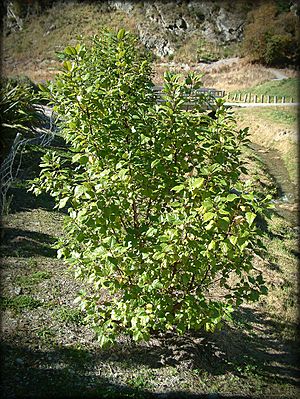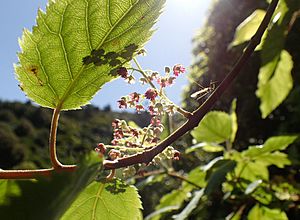Wineberry facts for kids
Quick facts for kids Wineberry |
|
|---|---|
 |
|
| Aristotelia serrata foliage | |
| Scientific classification | |
| Genus: |
Aristotelia (plant)
|
| Species: |
serrata
|
The wineberry (scientific name: Aristotelia serrata) is a small tree that grows in New Zealand. People also call it makomako or mako in the Māori language. It belongs to a plant family called Elaeocarpaceae. You can find this tree on the North Island, South Island, and Stewart Island of New Zealand.
Contents
What Does the Wineberry Look Like?
The wineberry is a small tree or shrub that grows quickly. It loses its leaves every year (it's a deciduous tree). This tree can grow up to 10 meters (about 33 feet) tall. Its trunk can be as wide as 30 centimeters (about 1 foot). The bark is light brown and smooth. Its branches are long and spread out. Younger branches often have a reddish-brown color.
Wineberry Leaves
Wineberry leaves are easy to spot. They are thin and have sharp, jagged edges, like a saw. The top side of the leaf is light or dark green. The bottom side is often pinkish-green. You can clearly see the veins on both sides. These leaves are usually between 5 and 12 centimeters long and 4 to 8 centimeters wide. They grow in pairs, either directly opposite each other or slightly offset.
The leaves have pointed tips and a clear net-like pattern of veins. Their edges are very toothed, with bigger, pointed teeth that also have smaller teeth on them. Some wineberry trees have red-purple twigs and leaf undersides, while others are just green. The leaves have long stems. At the base of each stem, there are two small, narrow leaf-like parts called stipules.
Wineberry Flowers
Wineberry flowers grow in large clusters. You can see many different colors of flowers mixed together, from cream to pink to dark red. Each flower is small, about 4 to 6 millimeters across. They have four petals that are often deeply lobed (meaning they have rounded cuts). There are many stamens (the parts that make pollen) around a special disc.
The flower clusters can be 6 to 10 centimeters long. Each flower sits on a slender stalk about 5 to 10 millimeters long. When the flowers first open, they are almost colorless. Then, they change to pink, red, and dark red, making a beautiful display.
Some wineberry plants have male flowers, and others have female flowers. Some male plants might also have a few flowers that have both male and female parts. Female flowers grow in large clusters on short shoots, usually on two-year-old wood.
Wineberry Fruits
The fruit of the wineberry is a small berry, about 4 to 5 millimeters wide. It changes color from red to dark red and then almost black when it's ripe. Inside, each berry has about 8 angular seeds.
Where Does the Wineberry Grow?
The wineberry tree is native only to New Zealand. You can find it all over the South Island and in the lower parts of the North Island. It grows well in damp forests and scrubland, from low-lying areas up to mountain and subalpine regions. It also grows on Stewart Island.
Where Wineberry Likes to Live
Wineberry trees love places where the forest has been disturbed. For example, they grow a lot in areas where trees have fallen naturally, or after landslides, storms, or forest fires. They are also common along the edges of damp rivers. This tree is one of the first plants to grow back in these clearings.
The Life Cycle of the Wineberry
The wineberry is a fast-growing tree that loses its leaves in winter. It might become completely bare before new leaves and flowers appear in spring. In spring, the tree looks lovely with its pinkish leaves and rose-colored flowers. The berries ripen in the summer. As the flowers get older, they change color from white to red.
Animals and Plants That Interact with Wineberry
The wineberry tree is a home or food source for many other plants and animals. Many types of mosses and other small plants grow on it. Native birds and insects also feed on the wineberry.
Birds and mammals like to eat the berries. The Kererū, a native New Zealand pigeon, is known to eat wineberry fruits. The Department of Conservation even suggests planting wineberry to help feed kererū populations. It's not just the berries that get eaten! The larvae (young caterpillars) of the Kawakawa looper moth (Cleora scriptaria) feed on the wineberry's leaves.
How People Have Used Wineberry
Both Māori and European settlers have used the wineberry tree in many ways.
Māori people used makomako for medicine. They would boil its leaves and put them on burns and infected wounds to help them heal. The berries were also a food source, often eaten by children. People could squeeze the berries to make a thick, sweet drink.
The wineberry plant can also be used to make dyes. The tree contains natural substances called tannins. The bark can be used to make a blue-black dye. European settlers would burn the shoots of the wineberry to make charcoal, which they used to produce gunpowder.
Interesting Facts About Wineberry
Ecology Fun Fact
Wineberry trees often grow in thick groups after a forest has been cut down.
Name Origin
The name Aristotelia comes from Aristotle, a famous ancient Greek philosopher.
Different Types?
Scientists think there might be two slightly different types of wineberry within the same species. One type has light green leaves and bright red fruits. The other has dark green leaves that are purplish underneath, and dark fruits.
Images for kids




